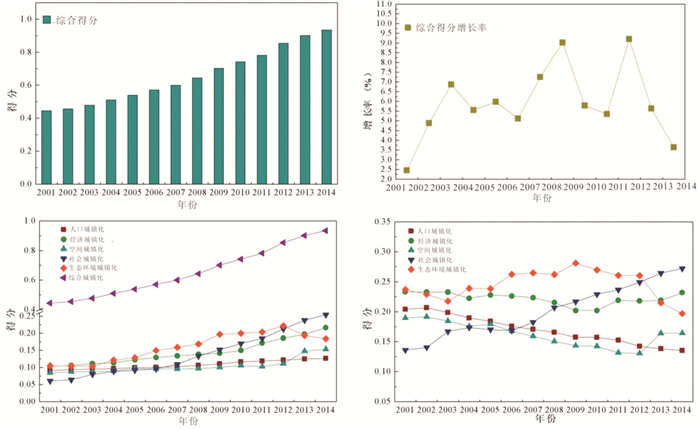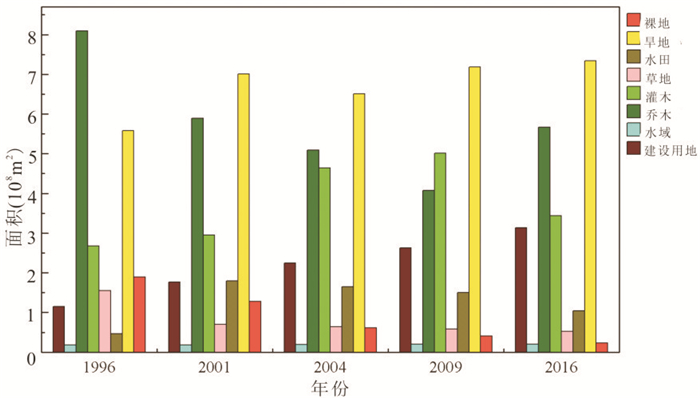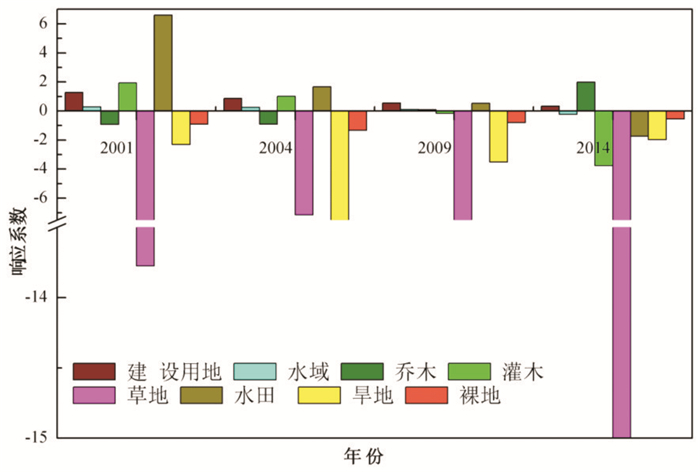The Relationship between Urbanization and Land Use in Guiyang City
-
摘要: 贵阳市岩溶地貌十分发育,可利用土地资源缺乏,城镇化发展与土地利用相互制约.基于贵阳市2001~2014年城镇化指标数据及1996、2001、2004、2009、2016年五期遥感影像数据,采用指标权重法和土地利用类型转移矩阵,分析了2001~2014年贵阳市城镇化发展趋势和1996~2016年土地利用的时空分布特征及演变规律.并运用相关性分析方法建立函数响应度模型,探讨了城镇化与土地利用之间的作用关系.结果表明:(1)2001~2014年间,贵阳市城镇化水平呈上升趋势,综合城镇化得分增长率为52.46%,其中人口(26.0%)、生态(20.4%)、空间(19.9%)和经济(18.3%)城镇化对综合城镇化贡献较大,社会(15.4%)城镇化相对较小;(2)贵阳市农用地、建设用地面积增加,净增长总量23.66%,未利用土地面积减少,净减少总量23.56%,土地利用类型总变化量为87.77%;(3)城镇化进程推动着土地利用的变迁,2001~2014年水田(13.767响应度)、裸地(4.476)、旱地(1.708)、灌木(1.319)土地利用类型对城镇化的综合响应度较高,乔木(0.897)、草地(0.878)、建设用地(0.693)、水域(0.180)相对较低.城镇用地面积的快速扩张是土地利用类型转变的直接因素.因此,建议在城镇化进程中,优化土地利用结构,以提高土地资源利用效率,保证城镇化进程可持续发展.Abstract: The karst landforms are widely developed in Guiyang and available land resources are limited, which leads to the constrains between urbanization development and land use. This study addresses the relationship between urbanization and land use. Based on the urbanization index data of Guiyang City from 2001 to 2014 and the remote sensing image data of 1996, 2001, 2004, 2009 and 2016, the index weight method and land use type transfer matrix were used to analyze the development trend of urbanization in Guiyang from 2001 to 2014. And the spatial and temporal distribution characteristics and evolution of land use in 1996-2016. And the correlation analysis method is used to establish the function responsivity model, and the relationship between urbanization and land use is discussed. The results show that:(1) In the period of 2001-2014, the urbanization level of Guiyang City showed an upward trend, and the comprehensive urbanization score growth rate was 52.46%. Among them, the population (26.0%), ecology (20.4%), space (19.9%) and economy (18.3%) urbanization contributed a lot to the comprehensive urbanization, and the socialization (15.4%) was relatively small. (2) The increase of agricultural land and construction land in Guiyang City, the total net growth was 23.66%, the reduction of unused land area, the total net reduction was 23.56%, and the total change in land use type was 87.77%. (3) The urbanization process promotes the change of land use. In 2001-2014, the comprehensive response of land use types to urbanization is higher in paddy fields (13.767), bare land (4.476), dry land (1.708) and shrubs (1.319). Trees (0.897), grassland (0.878), construction land (0.693), and waters (0.180) are relatively low. The rapid expansion of urban land use is a direct factor in the transformation of land use types. Therefore, it is recommended to optimize the land use structure in the process of urbanization to improve the efficiency of land use and ensure the sustainable development of urbanization.
-
Key words:
- urbanization /
- land use change /
- function response /
- Guiyang /
- remote sensing
-
表 1 城镇化综合水平评价指标体系及权重
Table 1. Urbanization comprehensive level evaluation index system and weight
一级指标 SEW MSD Wj 二级指标 SEW MSD Wj 效应 X1人口城镇化 0.163 0.089 0.126 X11城镇人口规模(万人) 0.258 0.336 0.297 + X12城镇人口比重(%) 0.244 0.145 0.194 + X13第三产业就业人数比重(%) 0.250 0.252 0.251 + X14人口密度(人/km2) 0.249 0.267 0.258 + X2经济城镇化 0.250 0.207 0.229 X21人均GDP(元) 0.187 0.291 0.239 + X22非农产业比重(%) 0.147 0.017 0.082 + X23规模以上工业总产值(万元) 0.193 0.305 0.249 + X24第三产业占GDP比重(%) 0.155 0.118 0.136 + X25第二产业占GDP比重(%) 0.151 0.076 0.114 + X26全社会固定资产投资占GDP比重(%) 0.168 0.192 0.180 + X3空间城镇化 0.167 0.147 0.157 X31建成区面积(km2) 0.276 0.324 0.300 + X32人均城镇道路面积(m2/人) 0.250 0.297 0.274 + X33人均城镇住房面积(m2) 0.253 0.212 0.232 + X34人均公共绿地面积(m2) 0.221 0.167 0.194 + X4社会城镇化 0.212 0.298 0.255 X41城镇居民人均可支配收入(元) 0.196 0.191 0.193 + X42人均社会消费品零售总额(元/人) 0.209 0.211 0.200 + X43每万人大学生数(人) 0.194 0.199 0.196 + X44城市公共汽车和出租车总量(万辆) 0.215 0.175 0.195 + X45汽车拥有量(万台) 0.209 0.223 0.216 + X5生态环境城镇化 0.208 0.258 0.233 X51生活垃圾无害化处理量(104 t) 0.211 0.234 0.222 + X52工业废水排放量(104 t) 0.208 0.249 0.229 — X53工业二氧化硫排放量(t) 0.209 0.244 0.226 — X54公共绿地面积(Hm2) 0.194 0.196 0.195 + X55建成区绿地率(%) 0.178 0.077 0.128 + 注:SEW代表熵值法计算所得权重; MSD代表均方差决策法计算所得权重. 表 2 1996~2016年贵阳市土地利用变化信息
Table 2. Information on land use change in Guiyang City from 1996 to 2016
项目 增加量(%) 减少量(%) 面积变化量(%) 总变化量(%) 交变化量(%) 净变化量(%) 建设用地 15.15 5.95 9.26 21.10 11.90 9.20 水域 0.19 0.08 0.15 0.27 0.16 0.11 乔木 13.06 24.31 -11.10 37.36 26.11 11.25 灌木 19.99 16.45 3.45 36.45 32.91 3.45 草地 4.02 8.73 -4.70 12.75 8.05 4.70 水田 8.44 5.80 2.70 14.24 11.60 2.64 旱地 23.37 15.19 8.10 38.57 30.38 8.18 裸地 3.54 11.26 -7.76 14.80 7.08 7.72 总量 87.77 87.77 0.0 87.77 64.10 23.67 注:面积变化量为20年间的土地利用差值,正为增加,负为减少. 表 3 贵阳市土地利用对城镇化的响应函数及其检验
Table 3. Response function of land use to urbanization in Guiyang City and its test
响应类型 响应函数yt $\frac{{{\rm{d}}{y_{jt}}}}{{{\rm{d}}{x_t}}}$ 拟合优度R2 统计量F 建设用地对城镇化响应 -1.000/xt +4.130 1/xt2 0.980 653.747 水域对城镇化响应 -0.171xt2 +0.26 xt +0.100 -0.342xt +0.269 0.889 52.974 乔木对城镇化响应 24.720xt2-34.148xt +16.081 49.440xt-34.148 0.961 159.659 灌木对城镇化响应 -27.161xt2+36.911xt-7.539 -54.322xt +36.911 0.826 31.871 水田对城镇化响应 -9.752xt2+13.134xt-2.834 -19.504xt-13.134 0.541 8.673 旱地对城镇化响应 -41.275xt2+63.378xt-16.463 -82.550xt +63.378 0.741 19.606 裸地对城镇化响应 exp(-4.303+2.397/xt) -2.397/xt2exp(-4.303+2.397/xt) 0.772 45.044 草地对城镇化响应 exp(-1.257+0.535/xt) -0.535/xt2exp(-1.257+0.535/xt) 0.692 30.252 表 4 贵阳市土地利用对城镇化的综合响应度比较
Table 4. Comparison of comprehensive response of land use to urbanization in Guiyang City
项目 2001~2004年 2009~2014年 2001~2014年 建设用地 1.072 0.260 0.693 水域 0.269 0.066 0.180 乔木 0.924 0.635 0.897 灌木 1.450 1.030 1.319 水田 9.700 11.701 13.767 旱地 3.517 0.480 1.708 裸地 5.101 1.524 4.476 草地 1.097 0.385 0.878 -
Cai, G.P., Zhang, C.Q., 2015. Temporal and Spatial Analysis of Land Use Changes Based on the Topography. Journal of Sichuan Agricultural University, 33(4):392-398 (in Chinese with English abstract). http://www.en.cnki.com.cn/Article_en/CJFDTotal-SCND201504007.htm Chen, R. S., Ye, C., Cai, Y. L., et al., 2014. The Impact of Rural Out-Migration on Land Use Transition in China: Past, Present and Trend. Land Use Policy, 40: 101-110. https://doi.org/10.1016/j.landusepol.2013.10.003 Cui, J., Du, J.Z., Li, X., et al., 2015. Effects of Land Use Change on Groundwater Quality in Qiqihar City. Earth and Environment, 43(3):308-315 (in Chinese with English abstract). http://www.wanfangdata.com.cn/details/detail.do?_type=perio&id=dzdqhx201503007 Deng, X. Z., Huang, J. K., Rozelle, S., et al., 2015. Impact of Urbanization on Cultivated Land Changes in China. Land Use Policy, 45: 1-7. https://doi.org/10.1016/j.landusepol.2015.01.007 Ding, L., Fang, X.J., Zhao, W.T., et al., 2015. Study on the Responsive Characteristics of Air-Environment in the Process of Urbanization in Wuhan. Resources and Environment in the Yangtze Basin, 24(6):1038-1045 (in Chinese with English abstract). http://www.wanfangdata.com.cn/details/detail.do?_type=perio&id=cjlyzyyhj201506019 Goertzen, D., Suhling, F., 2019. Urbanization Versus other Land Use: Diverging Effects on Dragonfly Communities in Germany. Diversity and Distributions, 25(1): 38-47. https://doi.org/10.1111/ddi.12820 Guo, J., Xu, Y. Z., Pu, Z. N., 2016. Urbanization and Its Effects on Industrial Pollutant Emissions: An Empirical Study of a Chinese Case with the Spatial Panel Model. Sustainability, 8(8): 812. https://doi.org/10.3390/su8080812 Hans, L., Koster, S., 2018. Urbanization and Start-Up Rates in Different Geographies: Belgium, the Netherlands, and Sweden. Small Business Economics, 51(4): 1033-1054. https://doi.org/10.1007/s11187-017-9967-2 http://cn.bing.com/academic/profile?id=f1ec93b33794186f8bc09a29d1e49c87&encoded=0&v=paper_preview&mkt=zh-cn Lambin, E. F., Meyfroidt, P., 2010. Land Use Transitions: Socio-Ecological Feedback Versus Socio-Economic Change. Land Use Policy, 27(2): 108-118. https://doi.org/10.1016/j.landusepol.2009.09.003 Li, G., Li, J.P., Sun, X.L., et al., 2017. Research on a Combined Method of Subjective-Objective Weighing and the Its Rationality. Management Review, 29(12):17-26 (in Chinese with English abstract). http://en.cnki.com.cn/Article_en/CJFDTotal-ZWGD201712003.htm Li, X.B., 2002. Explanation of Land Use Changes. Progress in Geography, 21(3):195-203 (in Chinese with English abstract). http://en.cnki.com.cn/Article_en/CJFDTOTAL-DLKJ200203000.htm Li, Y. H., Jia, L. R., Wu, W. H., et al., 2018. Urbanization for Rural Sustainability—Rethinking China's Urbanization Strategy. Journal of Cleaner Production, 178: 580-586. https://doi.org/10.1016/j.jclepro.2017.12.273 Liu, H. B., Zhou, Y. P., 2018. Urbanization, Land Use Behavior and Land Quality in Rural China: An Analysis Based on Pressure-Response-Impact Framework and SEM Approach. International Journal of Environmental Research and Public Health, 15(12): 2621. https://doi.org/10.3390/ijerph15122621 Liu, R., Zhu, D.L., 2010. Methods for Detecting Land Use Changes Based on the Land Use Transition Matrix. Resources Science, 32(8):1544-1550 (in Chinese with English abstract). http://d.old.wanfangdata.com.cn/Periodical/zykx201008016 Liu, X.W., Zhang, D.X., Chen, B.M., et al., 2008. Characteristics of China's Town-Level Land Use in Rapid Urbanization Stage. Acta Geographica Sinica, 63(3):301-310 (in Chinese with English abstract). http://www.wanfangdata.com.cn/details/detail.do?_type=perio&id=dlxb200803008 Liu, Y.B., 2008. Urbanization and Ecological Response Analysis of Jiangxi Province. Journal of Natural Resources, 23(3): 422-429 (in Chinese with English abstract). http://www.wanfangdata.com.cn/details/detail.do?_type=perio&id=CC0210483188 Lu, J., Jiang, M., Zhong, Z.S., et al., 2016. Analysis of Land Use Dynamic Change in Urbanization Process Based on Remote Sensing Monitoring—Taking Longquan City of Zhejiang Province as an Example. Anhui Agricultural Science, (25):191-195 (in Chinese with English abstract). http://en.cnki.com.cn/Article_en/CJFDTotal-AHNY201625063.htm Miranda, H., Gomes Júnior, E., 2017. Urbaniza o Reflexa: A Emergência de Arranjos Urbanos Intermediários No Brasil Pós-1990. EURE (Santiago), 43(130): 207-234. https://doi.org/10.4067/s0250-71612017000300207 Peng, C., Chen, L.Y., Han, F., et al., 2014. The Analysis of New-Type Urbanization and the Intensive Urban Land Use: Spatial-Temporal Evolution and Their Relationship. Geographical Research, 33(11):2005-2020 (in Chinese with English abstract). http://cn.bing.com/academic/profile?id=9ecf6f7b1cdc87313dcb96afc7036554&encoded=0&v=paper_preview&mkt=zh-cn Wang, F.X., Mao, A.H., Li, H.L., et al., 2013. Quality Measurement and Regional Difference of Urbanization in Shandong Province Based on the Entropy Method. Scientia Geographica Sinica, 33(11):1323-1329 (in Chinese with English abstract). http://www.wanfangdata.com.cn/details/detail.do?_type=perio&id=dlkx201311006 Wang, S. J., Ma, H. T., Zhao, Y. B., 2014. Exploring the Relationship between Urbanization and the Eco-Environment—A Case Study of Beijing-Tianjin-Hebei Region. Ecological Indicators, 45(10): 171-183. https://doi.org/10.1016/j.ecolind.2014.04.006 http://www.irgrid.ac.cn/handle/1471x/860507 Westlund, H., 2014. Urban Futures in Planning, Policy and Regional Science: Are We Entering a Post-Urban World? Built Environment, 40(4): 447-457. https://doi.org/10.2148/benv.40.4.447 Xu, L., Zhao, Y., 1993. Forecast of Land Use Pattern Change in Dongling District of Shenyang:An Application of Markov Process. Chinese Journal of Applied Ecology, 4(3):272-277 (in Chinese with English abstract). http://en.cnki.com.cn/Article_en/CJFDTOTAL-YYSB199303009.htm Xu, S.W., Liu, X.Z., 2006. Land Use Planning CAD System Based on GIS. Earth Science, 31(5):719-724 (in Chinese with English abstract). Yang, J., Xu, S.W., 2002. Design and Implementation of Land Use Database System for County Level of MAPGIS. Earth Science, 27(3):297-300 (in Chinese with English abstract). http://www.wanfangdata.com.cn/details/detail.do?_type=perio&id=dqkx200203014 Yuan, C., Ng, E., Norford, L. K., 2014. Improving Air Quality in High-Density Cities by Understanding the Relationship between Air Pollutant Dispersion and Urban Morphologies. Building and Environment, 71: 245-258. https://doi.org/10.1016/j.buildenv.2013.10.008 蔡广鹏, 张朝琼, 2015.岩溶山区不同地貌形态的土地利用变化比较分析.四川农业大学学报, 33(4):392-398. http://d.old.wanfangdata.com.cn/Periodical/scnydxxb201504007 崔健, 都基众, 李霄, 等, 2015.齐齐哈尔市土地利用变化及其对地下水水质的影响.地球与环境, 43(3):308-315. http://d.old.wanfangdata.com.cn/Periodical/dzdqhx201503007 丁镭, 方雪娟, 赵委托, 等, 2015.城市化进程中的武汉市空气环境响应特征研究.长江流域资源与环境, 24(6):1038-1045. http://d.old.wanfangdata.com.cn/Periodical/cjlyzyyhj201506019 李刚, 李建平, 孙晓蕾, 等, 2017.主客观权重的组合方式及其合理性研究.管理评论, 29(12):17-26. http://d.old.wanfangdata.com.cn/Periodical/glpl201712002 李秀彬, 2002.土地利用变化的解释.地理科学进展, 21(3):195-203. doi: 10.3969/j.issn.1007-6301.2002.03.001 刘瑞, 朱道林, 2010.基于转移矩阵的土地利用变化信息挖掘方法探讨.资源科学, 32(8):1544-1550. http://d.old.wanfangdata.com.cn/Periodical/zykx201008016 刘新卫, 张定祥, 陈百明, 等, 2008.快速城镇化过程中的中国城镇土地利用特征.地理学报, 63(3):301-310. doi: 10.3321/j.issn:0375-5444.2008.03.008 刘耀彬, 2008.江西省城市化与生态综合响应分析.自然资源学报, 23(3): 422-429. doi: 10.3321/j.issn:1000-3037.2008.03.008 卢建, 蒋敏, 钟张胜, 等, 2016.基于遥感监测的城市化进程中土地利用动态变化分析——以浙江省龙泉市为例.安徽农业科学, (25):191-195. doi: 10.3969/j.issn.0517-6611.2016.25.067 彭冲, 陈乐一, 韩峰, 等, 2014.新型城镇化与土地集约利用的时空演变及关系.地理研究, 33(11):2005-2020. http://d.old.wanfangdata.com.cn/Periodical/dlyj201411002 王富喜, 毛爱华, 李赫龙, 等, 2013.基于熵值法的山东省城镇化质量测度及空间差异分析.地理科学, 33(11): 1323-1329. http://www.wanfangdata.com.cn/details/detail.do?_type=perio&id=dlkx201311006 徐岚, 赵羿, 1993.利用马尔柯夫过程预测东陵区土地利用格局的变化.应用生态学报, 4(3):272-277. doi: 10.3321/j.issn:1001-9332.1993.03.001 徐世武, 刘秀珍, 2006.基于GIS的土地利用规划辅助编制系统.地球科学, 31(5):719-724. http://www.cnki.com.cn/Article/CJFDTotal-DQKX200605028.htm 杨军, 徐世武, 2002.县(市)级土地利用数据库系统的构建和实现.地球科学, 27(3):297-300. doi: 10.3321/j.issn:1000-2383.2002.03.014 -










 下载:
下载:



